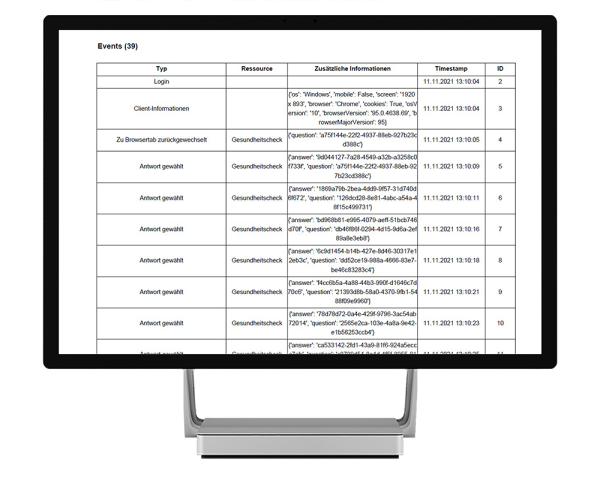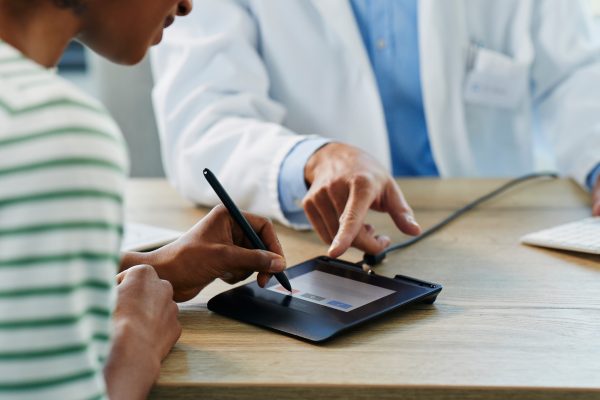From a meta-perspective, the informed consent discussion fulfils two basic functions: On the one hand, it should give patients the opportunity to understand a treatment, weigh up the success and risks and decide in favour of or against it. On the other hand, by creating a treatment contract, the informed consent discussion fulfils the intention of protecting doctors against liability.
It is commonly known that doctors need that doctors need to have the informed consent discussion verbally with their patients. Documenting the conversation helps with this. A patient's signature on an information sheet doesn't fully protect the doctor from liability. What really matters is that the doctor's notes show the patient understood the verbal explanation. The signature is just one part of this. That's why it's common and helpful for doctors to make notes and personal marks on information sheets, as this shows a discussion happened during the consultation.
Secure and insecure workflows in clinics and practices: the perspective of handwriting analysis
The science of handwriting examination emancipated itself from graphology in the second half of the 20th century. Graphology refers to the (scientifically untenable) attribution of psychological characteristics on the basis of writing.
Today, forensic document examiners are primarily trained in government agencies (such as crime laboratories) and courses (e.g. in Germany a university course exists at the Faculty of Psychology at the University of Mannheim) and work as executive officers or freelance court experts. A common way of comparing handwriting is as follows: a disputed signature is compared with a series of admitted signatures. The decisive factor for the evaluation is the methodical examination of written characteristics. In view of the usual variance in writing performance, the apparent form of a signature plays a rather subordinate role (the tracing of a signature is easy to recognise for an expert). More important are parameters such as speed, range of motion, pressure or pen position. Special circumstances such as hand support, hand guidance or the influence of medication can be examined and occasionally play a role. In addition, a physical-technical document examination exist as a standard procedure, which is aimed at questions regarding the manipulation or the age of a document, for example by gas chromatography. The handwriting expert only gives an opinion in court on the question of authorship on the basis of a statement of probability. The availability of sufficient examination material is central to the work of a handwriting expert. Only original written documents are suitable for this purpose. In view of the established examination methods, no handwriting expert is able to prepare expert opinions on the basis of scans or photocopies.
If a handwritten signature (i.e. a pattern of movements physically made with a pen on paper) shall be examined, the document must be kept in paper form in order to make examination possible and preserve evidence. Hence, it is not enough to keep an electronic copy.
From the perspective of written forensics, the procedure of signing, scanning and copying a paper questionnaire, but not keeping the original, should be rejected both in medical practices and in clinics.
The same applies to notes on the information sheet. It is important, for example, that all additional notes made by the doctor are made on the same original information sheet. It is not advisable to have ‘double-track’ documentation (e.g. signature on the information sheet, but data entry and notes in the electronic system). On the other hand, it is safer to keep purely manual documentation in paper form and to retain the original document in accordance with legal requirements.
Certainty of electronic solutions
Levelling up legal security collecting time stamps and data points
Particularly in hospital departments and practices with high documentation requirements and a high numbers of examinations, the question arises as to what extent workflows can still be implemented efficiently with paper questionnaires. Aspects such as cross-departmental communication and data transfer can -- if there is a lack of modern IT -- only be processed via increased personnel deployment. Legal certainty in electronic informed consent, on the other hand, often seems to be the obstacle of digitalisation. This tends to ignore that collecting a number of data points can make electronic informed consent far more legally secure. Thus, technical procedures can be used to prove that patients were able to follow the content and engage with the subject matter.
When providing content to patients, it is possible to use authentication to determine that a specific person is receiving the information (one option, for example, is access via a mobile phone code, as we know it from online banking). The completing of educational modules, viewing time and interaction with questionnaires can be tracked and time-stamped. Patients can use input fields to indicate whether or not they have understood the content. Finally, they can also formulate their own questions and send them to the doctors. It is then possible to issue a summary of the success of the content transfer as a report to those doctors who can then address precisely the open questions during the information session and document them directly in the electronic file.
Similar to forensic handwriting examination, IT forensics is a topic that courts have to deal with. In a very similar way, IT forensic experts use predefined methods to secure and analyse data and make statements in the course of an expert opinion. Cleverly collected data points in the course of a patient education and informed consent (including the doctors' interaction with the electronic file, during or after the medical discussion, including time stamps) can prove the transfer of information in the case of a forensic evaluation with much greater certainty than can be achieved with manual notes on a paper sheet.
Electronic Signatures
EU law has changed in recent years with regard to the validity of electronic signatures (particularly concerning the eIDAS regulation, which will not be discussed further here). Thus, a signature may not be considered invalid in court simply because it is in electronic form. The advantages of electronic documentation and electronic signature are obvious for clinics and practices, but what about the forensic perspective?
No doubt -- it is possible to implement electronic signatures with the highest level of security (so-called qualified electronic signatures). However, in such cases the question always arises as to what extent usability and security can be balanced. The highest security requirements, such as the integration of a trust service provider (TSPs) and a process that guarantees complete identification, are possible, but are initially associated with hurdles for patients, because they have to go through a more complex identification process before signing. This hardly seems handy in a clinical context (in the future, however, the widespread distribution of an ‘electronic citizen card’ in conjunction with the health insurance card could represent a very simple and practicable solution to this process).
Signing on glass
However, the use of a special device to capture a handwritten writing movement seems simple. The term ‘signing on glass’ refers to the use of special electronic signature tablets, which have been used for years in banks, insurance companies and other sensitive areas. These tablets are able to capture several writing characteristics in the sense of writing forensics. In terms of pressure progression, speed of movement or the angle of the writing instrument, they are even superior to classic handwriting comparison, as in this case it is not actually possible to refer to handwriting characteristics, but rather to collect original data records (in the early 2000s, basic research in handwriting forensics worked with so-called methods for the on-line collection of movement patterns in order to substantiate assumptions in handwriting forensics).
This data on the creation process of a written record makes the procedure fairly reliable and should be completely sufficient for the vast majority of use cases in a clinical context. In addition, the signature on a device in the treatment room can prove that the patient was present in the temporal context of the documentation (a paper information sheet handed out by reception can hardly fulfil this task).
Summary and outlook
The forensic security of handwritings and signatures concerning medical informed consent can be assessed as follows: Documentation on a paper questionnaire offers the highest level of certainty with regard to a disputed signature. If the (admittedly not very probable) question of a forged signature were to arise in court, the handwriting expert would have the best evidence available, provided that the entire documentation is in paper form and the original document is kept. From a mere forensic point of view, however, a mixture of digital and analogue documentation is unfavourable, in which, for example, documentation is made on paper sheets but then scanned for storage, or in the case of signed paper sheets and parallel electronic documentation of the notes on the informed consent discussion.
When it comes to the entire process of documenting a consultation an intelligent electronic solution with time stamps is ahead of paper consultation forms, as it is able to create better traceability of the information transfer through numerous data points. The probative value of the digital signature (‘Sign on Glass’) should at least fulfil the requirements of an advanced electronic signature (AES / eIDAS) within intelligently solved software processes, as it is sufficient for most legal transactions, such as a car purchase or an insurance contract. It can be assigned to the signatory with a high degree of probability through the collection of several written characteristics.
Overall, this digital process of medical history and patient information, the collection of time stamps and data points and the completion by an AES offers the highest level of forensic security and represents the optimal balance between usability and legal certainty. However, it is foreseeable that in the very near future, digital patient information will achieve a significantly higher level of forensic analysability in the event of liability issues than is possible with paper information sheets and manual documentation. This is mainly due to the spread of electronic citizen cards, with which the use of qualified electronic signatures (which are legally equivalent to manual signatures) could become common practice



